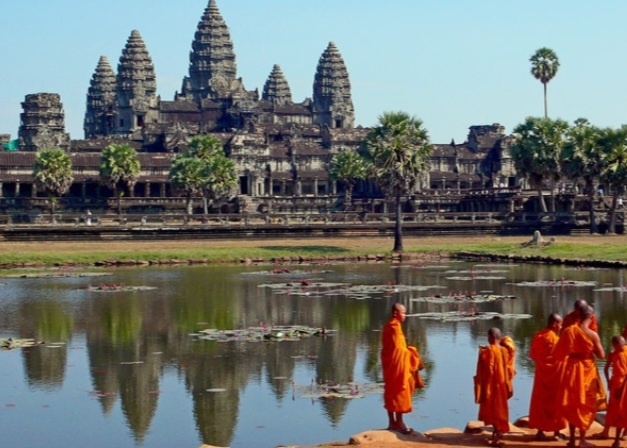Angkor Wat is more than Cambodia’s national symbol. It is more than the largest religious monument on Earth. It is a living, breathing spiritual legacy carved in stone — a temple that has stood the test of time, war, nature, and human curiosity. For centuries, Angkor Wat has drawn pilgrims, historians, artists, and wanderers, all seeking to understand the mystery and power that emanates from this 12th-century marvel.
But beyond the awe-inspiring architecture and Instagram-famous sunrise photos lies a deeper world — one filled with spiritual symbolism, historical riddles, and secrets hidden in plain sight. Whether you're planning a visit or exploring from afar, this guide to Angkor Wat's hidden gems and sacred mysteries will open your heart and sharpen your curiosity.
The Origins of Angkor Wat: Sacred Geometry and Divine Purpose
Built in the early 12th century by King Suryavarman II, Angkor Wat was originally constructed as a Hindu temple dedicated to Vishnu, one of the principal deities of the Hindu trinity. Over time, it transitioned into a Buddhist temple, reflecting the shifting spiritual tides of the region. But rather than being a simple change of religion, this transition reveals the inclusive, layered nature of Khmer spirituality.
Every stone of Angkor Wat is infused with intention. The entire temple complex is laid out in alignment with cosmic principles. The central tower represents Mount Meru — the mythical center of the universe in Hindu and Buddhist cosmology. The surrounding moat symbolizes the cosmic ocean. The orientation of the temple, unusually facing west, has sparked endless debate. Some scholars believe it honors Vishnu, associated with the western direction, while others link it to death and the afterlife, suggesting Angkor Wat may have functioned as both temple and royal tomb.
Hidden Secret #1: The Solar Mysteries of Angkor Wat
Twice a year, during the spring and autumn equinoxes, the sun rises directly over the central tower of Angkor Wat when viewed from the western entrance. This astronomical alignment is no accident — it reflects the Khmer Empire’s deep understanding of time, space, and divinity. Ancient builders designed Angkor Wat to be not just a religious site, but a cosmic calendar, anchoring the heavens to the earth in sacred harmony.
Hidden Secret #2: The Whispering Gallery
Inside the main temple, there exists a mysterious acoustic phenomenon known as the Whispering Gallery. Stand in one corner of the hallway and whisper — someone standing diagonally across can hear you clearly, even though you're speaking softly. While it may seem like a neat trick of architecture, many spiritual visitors believe the acoustics amplify mantras and prayers, allowing sacred sounds to reverberate through stone, space, and spirit.
Hidden Secret #3: The Bas-Reliefs That Tell Ancient Stories
The temple’s outer galleries are adorned with over 800 meters of intricately carved bas-reliefs, depicting scenes from Hindu epics like the Ramayana and Mahabharata. But among these grand scenes are smaller, lesser-known carvings tucked into corners and shadows — including historical graffiti from centuries past. Khmer pilgrims, monks, and even Japanese visitors in the 17th century left their marks in the form of dates, prayers, and poems.
Look closely, and you might find a carving of a stegosaurus-like creature, fueling speculation about lost knowledge or playful artistry. More likely, it’s a stylized rendering of a rhinoceros or boar — but the mystery persists, and tourists continue to search.
Hidden Secret #4: The Active Shrines Off the Tourist Track
While the central towers of Angkor Wat draw massive crowds, many visitors miss the active Buddhist shrines nestled in the quieter corners. Here, locals still come to light incense, pray, and make offerings to golden statues of the Buddha. These sanctuaries are alive with the scent of jasmine and sandalwood. The hush in the air is sacred, not silent — a powerful reminder that Angkor Wat is not a ruin but a living place of devotion.
Hidden Secret #5: The Doorways to Nowhere
Angkor Wat’s layout includes numerous false doors — beautifully carved entrances that lead into solid stone. In Khmer architecture, these doors serve symbolic rather than practical functions. They represent passages to the divine, or portals for spirits. Much like Tibetan mandalas or Egyptian tombs, the architecture here merges the physical and metaphysical, reminding us that not all doors are meant to be opened — some are meant to be contemplated.
The Spiritual Atmosphere of Angkor: Not Just Stones, but Soul
To walk the grounds of Angkor Wat at dawn, before the crowds arrive, is to experience a profound quiet. The trees hum, the sandstone warms under the rising sun, and the past feels unusually close. For many, Angkor Wat is not just a travel destination but a spiritual retreat. Buddhist monks in saffron robes wander the grounds, blessing visitors. Solo travelers sit in meditation by lotus pools. Photographers chase not just the perfect shot, but a moment of transcendence.
The energy of devotion — layered over centuries — still clings to every step, every smile, every worn stair. Whether you come seeking insight, beauty, or a brush with the sacred, Angkor Wat meets you with an open heart and ancient wisdom.
|
|

